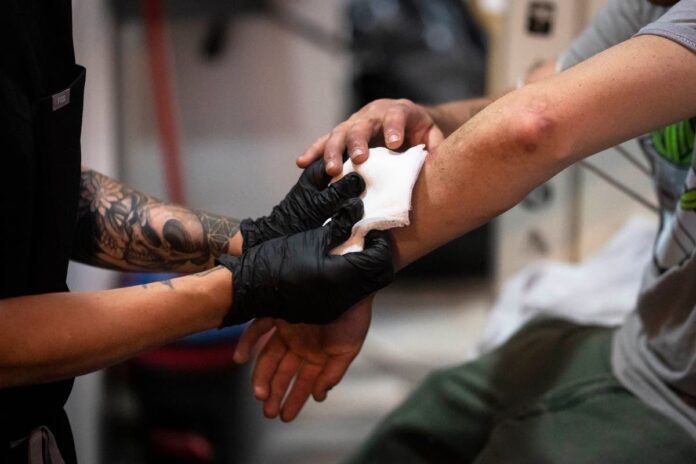Federal officials on Tuesday called for more testing and research on xylazine, the powerful animal sedative that’s spreading through the nation’s illicit drug supply, but they stopped short of recommending new restrictions on the veterinary medication. A six-point plan from the White House ‘s drug control office aims to scale up testing, treatment and efforts to intercept illegal shipments of xylazine, which is being mixed into fentanyl and other illicit opioids. The White House declared xylazine-laced fentanyl an ’emerging threat’ in April and called for a national strategy to combat its use. Xylazine, sometimes known as tranq, can cause breathing and heart rates to fall to dangerous levels when used in humans. When injected it can cause large open sores and infections, sometimes leading to amputation. In the report released Tuesday, drug czar Dr. Rahul Gupta said administration officials will ‘explore’ making xylazine a scheduled drug, subject to regulatory restrictions similar to opioids and amphetamines. While some states have already scheduled the drug, those efforts have faced pushback from veterinarians, farmers and others who regularly work with it. Federal scheduling limits how drugs can be prescribed, dispensed and stored. Several bills in Congress aim to tighten use of xylazine without limiting its legitimate use in sedating horses, sheep and other animals. The bulk of the White House’s plan focuses on improving how use of the drug is tracked and treated by health professionals. ‘We need more testing to get a national picture of the threat,’ Gupta told reporters. Current testing for xylazine is a patchwork of different approaches, with some medical examiners and health departments regularly detecting the drug in deceased overdose victims and collected drug paraphernalia. Recent federal figures suggest use has mushroomed in recent years. But a standardized testing approach is needed to understand the trajectory and scope of the drug’s spread. The plan also calls for the development of rapid tests for use by hospital staff and community workers who treat patients experiencing overdoses. Developing medical billing codes for the treatment of xylazine-impacted patients is another step needed to complete the data picture, officials said. Other key goals include: – Developing and educating health professionals on best practices and medications to treat xylazine withdrawal and addiction. That includes treating the skin wounds associated with xylazine. – Identifying and disrupting illegal imports of xylazine from overseas, including from China and Mexico. – Researching new drug options to quickly reverse the effects of xylazine, which can cause users to black out. Because it is not an opioid, xylazine does not respond to the standard opioid-reversal drug, naloxone. If successful, federal officials hope the strategy will reduce xylazine-related overdose deaths by 15% by 2025. The plan does not include new federal funding, which senior administration officials said depends on Congress. They noted that President Joe Biden’s most recent drug control budget called for $46 billion to expand addiction treatment and disrupt illegal drug supplies. The government’s xylazine plan will be distributed to federal agencies, including the Food and Drug Administration and the Drug Enforcement Administration , which will be tasked with helping implement it. ___ The Associated Press Health and Science Department receives support from the Howard Hughes Medical Institute’s Science and Educational Media Group. The AP is solely responsible for all content.
White House lays out effort against animal sedative xylazine but doesn’t call for new restrictions
Sourceindependent.co.uk
RELATED ARTICLES


